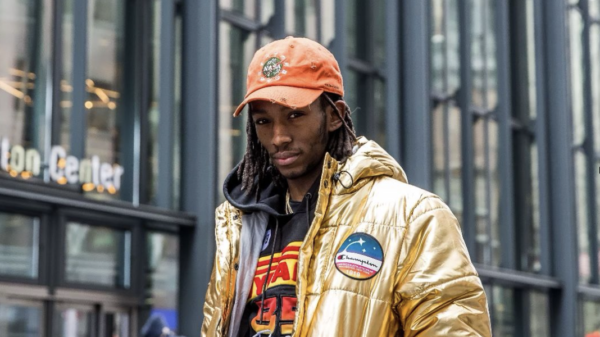I
f you drive 40 minutes south of Birmingham, England, you’ll find the quiet, serene village of Tanworth-in-Arden, where fans flock year-round to visit the grave of Nick Drake, who grew up and died here more than 50 years ago. At the time of his death of an overdose at age 26, he’d released just three albums: his 1969 debut, Five Leaves Left, 1971’s Bryter Layter, and the most beloved, 1972’s Pink Moon.
It would be decades before Drake gained a cult audience — the devoted, feverish kind that scours the internet for any video footage of him (there isn’t any) and dreams up future biopics (there won’t be any). He’s been so mythologized over the years that, for many listeners, he’s more of an ethereal, tragic figure shrouded in mystery than a real person. But a new box set, chronicling the creation of Five Leaves Left, offers a glimpse into the real Drake — the living, breathing musician who was incredibly gifted, utterly charming, and ahead of his time. After nearly a decade in the making, the set is finally out on July 25, via Island/UMe.
Spanning four LPs (or four CDs, if that’s your thing), The Making of Five Leaves Left contains 30 previously unheard tracks, including demos and studio outtakes. “I knew Nick was making this album (we were sharing a flat in London at the time), but I had no idea how advanced it was until he came into my room one day and said ‘there you are’ and threw the album on my bed,” says his sister, actress Gabrielle Drake. “I was astounded. I loved this album on the day I first heard it — and I have loved it ever since.”
The idea for the box set dates back to early 2016, when Neil Storey, the former head of publicity for Island Records, received a phone call from Johnny Chandler, who worked in A&R. Storey grew up in Tanworth-in-Arden, and though he never met Drake, their parents knew each other. He began working at Island in 1974, and still does consulting work for Universal. “‘The gray hair is real,” he jokes on a Zoom from his home in France.
Editor’s picks
Storey says Chandler had a top-secret request for him. “It was all very discreet,” he remembers. “I suppose I had a bit of a reputation for not blabbing about things. He said, ‘Look, I’ve got this idea, can you delve into the archives and see what might exist for Five Leaves Left?’ But the thing is, you cannot tell anybody. You absolutely cannot tell anybody at all. This is the most hush-hush project imaginable.’ Nick is serious currency, for God’s sake, and I understood that.”
Storey was doubtful he’d find anything in the archive, since tapes in those days were often either recorded over or destroyed. “That initial conversation with Johnny was, ‘There really isn’t going to be anything,’” Storey recalls. “And amazingly, there was far more than I thought there was going to be … How lucky are we?”
We’re lucky for many reasons, beginning with the fact that the estate — managed by Gabrielle and Cally Callomon — typically avoids archival releases or box sets. “They’ve never done stuff like this before,” Storey says. “There were certain [people] within the record company, I won’t name them, who said, ‘Oh look, it’s this anniversary, it’s that anniversary. Why don’t we do it around this?’ And Gabrielle, me, and Cally, we were going, ‘You must be kidding. It doesn’t work like that at all.’ Nick’s music is timeless. So therefore, why peg it to something that’s so fucking bleak and obvious?”
When Chandler and Storey presented the tapes to Callomon, the estate executor didn’t think they warranted a release. “I was fascinated from the archaeological point of view, but not from the commercial point of view at all,” Callomon tells Rolling Stone on a Zoom call from London. Gabrielle agreed: “I have always been of the opinion that any work of art must go through an evolutionary process which includes failure and mistakes, wrong turnings, despair, culling, and occasional elation,” she says. “The artist wants us to see or hear the result, not the painful process. This would have applied above all to Nick, the perfectionist. So, on his behalf, I have always eschewed the completist approach.”
Related Content
So, what changed? The answer is the magic ingredient to any archival release: unearthed tapes. The first is a tape of demos that mark Drake’s first sessions at London’s Sound Technique in March 1968, where he’d record his three albums with producer Joe Boyd and engineer John Wood. At the time, Drake was attending Fitzwilliam College, Cambridge, and was connected to Boyd through Fairport Convention bassist Ashley Hutchings.
“I grew up listening to blues and jazz, [and] all the people who were imitating Dylan were less interesting to me,” Boyd says. “I wasn’t so interested in white middle-class people strumming guitars and singing about their angst. It sounds snobbish and stupid, but that was my take at the time. And what I loved about Nick was that he didn’t sound like anybody else. I was hooked from the beginning, [and] never had a moment’s hesitation about wanting to work with him.”
The tape, found on a mono reel, belonged to folk singer Beverley Martyn, formerly married to the late musician John Martyn. “He was chums with John and Bev, and he’d have taken it around to play it to them, I guess,” says Storey, who wrote the box set’s liner notes with Richard Morton Jack (author of an excellent 2023 Drake biography). “Maybe he just got stoned and walked off and didn’t bother collecting it, and it would’ve sat in a drawer.”
In the demo, you can hear Drake — who was just 19 at the time — perform fleshed-out songs like the outtake “Mayfair” and an early version of “‘Cello Song” (then titled “Strange Face”). “To hear those demos from the first session, you can get a feeling of what I heard. The skill on the guitar, the cleanliness and the complexity of what he was playing,” Boyd says.
“You could call it an audition tape,” Wood adds. “Nick walked into the studio the first time, and he was fully formed as an artist then.”
Sound Technique’s control room overlooked the recording floor, and Boyd often sat there while Wood and Drake worked below. The engineer spent a lot of time with Drake, even sometimes driving the songwriter back to Cambridge on his own way home to Suffolk. “I always had a very easy relationship with Nick, and we’d talk about anything,” Wood says. “He had a sense of humor. He wasn’t dour at all, but he was quiet.”
You can get a sense of Drake’s personality on the second tape, cut on a Grundig reel-to-reel recorder in the fall of 1968 by fellow Cambridge student Paul de Rivaz, whom Drake met the previous year. “I will never forget his rendition of ‘House of the Rising Sun,’” de Rivaz tells Rolling Stone. “The guitar riff at the beginning was absolutely made for him.”
Drake was working with arranger Robert Kirby, who was also attending Cambridge at the time. It’s fascinating and intimate, as though you’re sitting in the room with these university students. Fans will likely lose their minds here as they hear Drake actually speaking before each track, appearing chatty and joyful, a stark contrast to how the public perceives him. “As you can tell from some of the comments in the tape, he was jolly about a number of things, and quite jokey,” says de Rivaz. “I’m so glad we can reveal the true Nick,” adds Gabrielle.
Before the crisp, delightful “Mickey’s Tune” — completely unheard until now — Drake admits the tape is proving to be “unprofessional,” and jokes that he’s intoxicated, though de Rivaz says he was probably just hungover. (When I mention this moment to Wood, he said, “Nick certainly smoked weed, but he never, ever worked when he was anything other than absolutely stone-cold sober.”)
The direction that Drake gives Kirby on the tape — possibly some flute here, a string quartet there — demonstrates that even before his debut was recorded, Drake knew how he wanted his music to sound. (The liner notes reveal he was a fan of the Beach Boys’ 1966 classic Pet Sounds.) “At that very young age, he knew exactly what he wanted, and this recording showed it,” Gabrielle says. This proved to be especially true when musician Richard Hewson first contributed arrangements to the album, and an unsatisfied Drake used Kirby instead. “I think it’s a bit of a sore subject, to be honest,” Storey says of Hewson’s early involvement.
De Rivaz ended up keeping the tape, and never forgot about it in the ensuing decades. “I knew it was worth keeping,” he says. “I thought, ‘Well, a little bit of history, I’ll keep it.’” Though de Rivaz traveled the world for his job with British Petroleum, he kept the tape safe in his London home, refusing to fly abroad with it in fear of magnetic scanners at airports. A lifelong horse rider, he connected with Chandler in April 2017 through his fellow polo player Kenney Jones (drummer for the Faces and the Who). “I was sitting at home,” de Rivaz remembers. “The phone rang, and somebody said, ‘Hello, I’m Johnny Chandler from Island Records, and I think you might have an interesting tape.’”
De Rivaz then met with Callomon and Gabrielle at Abbey Road. “I duly appeared and said, ‘This is the tape, which you’re not going to play, and this is the CD, which has a copy of what’s on it,’” he said. “When it finished, there was this sort of silence, and poor Gabrielle was physically a bit upset, hearing her brother after so many years.”
Asked about this moment, Gabrielle tells Rolling Stone, “It was a sudden light thrown onto the Nick of my youth and his — a Nick too often hidden behind the cloud of his final sad years.”
UNLIKE MANY ARCHIVAL RELEASES, The Making of Five Leaves Left is carefully curated, showcasing the development of earthy gems like “Day Is Done” without excess material. You won’t find any content dump here — no 17-CD edition, no dozens of alternate takes. “No track has been arbitrarily chosen: each has a purpose and a place in the story, even the rejects, and the reasons are given in the written documentation that accompanies the four albums,” Gabrielle says. “The fourth one being Five Leaves Left as Nick wanted the world to hear it.”
“Gabrielle guards Nick’s legacy like a lioness with newborn cubs,” Storey says. “She will fight people off for, ‘No, you cannot do this, cannot do that, can’t do the next thing.’ She was absolutely at the forefront of, ‘If we’re going to do this, then it has to honor Nick’s legacy. So yes, we’ve got another four takes of this. We’ve got another five takes of this. No, we are not using all of that. This has to be the best, the absolute best of what has never been heard before.”
Callomon says the estate also thought about including Drake’s 1969 BBC sessions, but they wanted to keep the box set affordable for fans. “They just wanted the most appallingly huge amount of money, and I wanted to keep the set down in price,” he says. “So although there’s going to be a lot of people saying, ‘It’s too expensive,’ it’s the cheapest it could possibly be, and it’s not audiophile vinyl. There’s no Blu-ray. There’s no Dolby Atmos remixes or anything, because that would just put it up into the Bruce Springsteen $300 territory, which is great for Bruce, but not for us.”
Wood wasn’t exactly thrilled to learn The Making of Five Leaves Left was being released. “I have to say, it’s not something that I’m a great fan of,” says the engineer, who also wasn’t pleased when Drake’s final recordings — like the melancholic, funereal “Black Eyed Dog” — were released in the late Eighties. “I have to be a bit blunt about this, but the whole idea of issuing outtakes has never been anything that I have to say that I’m very in favor of. My attitude is, if the artist had wanted it to go out, it would’ve gone out at the time.”
Boyd had a similar perspective until a month ago, when he learned of the box set’s existence. “With a great deal of skepticism, my wife and I sat down one evening and listened to all four discs, and I was completely moved by it,” the producer says. “I’m now its biggest supporter.”
When I ask Callomon if he agrees with Storey’s description of Gabrielle as a lioness, he says only partially. “She’s not so much protective as defensive,” he says. “For example, we’ve never made a biographical feature film on Nick.”
This is an aspect Drake fans are obsessed with, especially with recent biopics on other revered artists like A Complete Unknown, Elvis, and Bohemian Rhapsody. Even on the day of our interview, Callomon had just received another pitch for a film. “There is a demand,” he says. “[But] we always say no. Gabrielle and myself, we don’t want Nick to be seen on screen played by an actor. We’ve spent so much time getting people to cultivate their own Nick Drake, and it being a very personal relationship that they have with [him].”
Nick Drake-Summer 1969
Alex Henderson*
Callomon began working for the Drake estate in the late Nineties, right before the 2000 Volkswagen commercial featuring “Pink Moon” finally exposed a mass audience in America to his music. “I just got really interested in managing a dead artist as if he was a living, breathing artist,” he says. Oddly, the estate will occasionally get requests for Drake to perform at festivals and on TV programs, coming from bookers who must not realize he’s been dead for half a century. “They obviously have a list of what their demographic is and what the people like, and nobody checks if the person’s still alive,” he says. “I find that really gratifying.”
Drake did few interviews in his lifetime, and performed in public under 30 times. Any suspected video footage of Drake, Callomon says, isn’t him: “It only adds to the mystery, doesn’t it? They could all be Nick and none of them could be Nick. Gabrielle thinks none of them are Nick.”
Whether or not we’ll ever see a Bryter Layter box set in the future is anybody’s guess — but one can imagine how gorgeous fan favorites like “Northern Sky” would sound as sparkling, stripped-down demos. “I wouldn’t want to just do something like that just for the sake of it,” Storey says. For its original engineer and producer, the album is a rare case of perfection. “It’s very seldom that you make a record where you think that you’ve got everything right,” Wood says. Boyd agrees: “I can just sit down on the sofa, put my feet up, drop the needle on, and listen from beginning to end and never think I should have done this or that.”
Boyd and Wood admit it was painful for them to listen to Pink Moon, the album on which Drake abandoned arrangements and was accompanied solely by guitar and piano. “I thought, ‘What a disaster,’” Boyd says. “Any chance that he had of becoming successful, he’s really just thrown it away. Of course, it now sells better than the other two.”
Trending Stories
The Making of Five Leaves Left shines a new light on Drake, far away from the darkness and heartbreak of his final years. There might not be an anniversary peg, but it’s a fitting release for the summer — the breezy and bright kind, with no clouds in sight. “It’s one of the most special things I’ve ever been involved in,” Storey says. “What I really hope, in 50 years time, when I’m long gone, people look back at it and go, ‘Wow, that was a really worthwhile thing to have.’’
“For me, as Nick’s sister, who so often has to wonder whether I am making the right decision for him, I am as sure as I can be that with this box set we are giving his fans what they deserve,” Gabrielle says. “I think Nick himself would have endorsed it, wryly smiling and saying, ‘Yep. It’s OK.’”

























